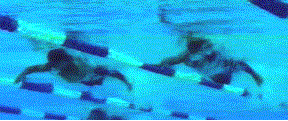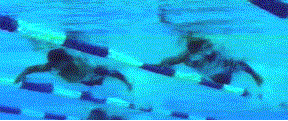

FURTHER EVIDENCE FOR WHY AMERICAN MALE DISTANCE SWIMMERS WILL NOT CHALLENGE THE AUSTRALIANS (ERIK VENDT AND LARSEN JENSEN AT THE USA 2004 OLYMPIC TRIALS IN LONG BEACH)
Each Frame is .1 seconds apart. The event is the 1500-m final at the 2004 USA Olympic Trials in Long Beach. The exact location in the 1500-m race is not known.
This stroke analysis includes a moving sequence in real time and a moving sequence where each frame is displayed for .5 of a second.
The following image sequence is in real time. It will play through 10 times and then stop. To repeat the sequence, click the browser's "refresh" or "reload" button.

The following image sequence shows each frame for half a second. It will play through 10 times and then stop. To repeat the sequence, click the browser's "refresh" or "reload" button.

The purpose of displaying these two swimmers together is to show that male distance swimmers in the USA are on the wrong technique track. A catch-up stroke with a big six-beat kick emphasizes actions that have been shown to be costly in energy consumption and inefficient in terms of fluid mechanics.
Another feature of the catch-up stroke is that it reduces the length of effective propulsion in the latter stage of the stroke. Both swimmers do not exploit the extension of the elbow followed by an optimal round-out at the end of their strokes.
Both swimmers also exhibit an exaggerated S-shaped pulling pattern because of the extended period of flat shouldered swimming that is associated with the catch-up stroke. During the insweep phase, both swimmers display a sudden slip through the water, which produces a brief loss in propulsive forces further exaggerating the violation of Newton's First Law and increasing the inefficiency of the energy to progression ratio.
These criticisms of two dedicated very good athletes are not meant to be harsh. They are pointed at the fact that the two best 1500-m swimmers in the USA are on the wrong technique track. By de-emphasizing kicking to mainly a four- or two- beat cadence in most of the race, the arms will be freed to produce a more consistent balanced stroke that will contribute to consistent and effective propulsion. When American males embark on that approach to distance crawl stroke, perhaps then Australian male distance swimmers will be threatened.
[Editor's Note. The emphasis here is on males. It has become quite evident that there is a distinct gender difference in the appropriate technique features of successful distance swimming.]
Return to Table of Contents for this section.
